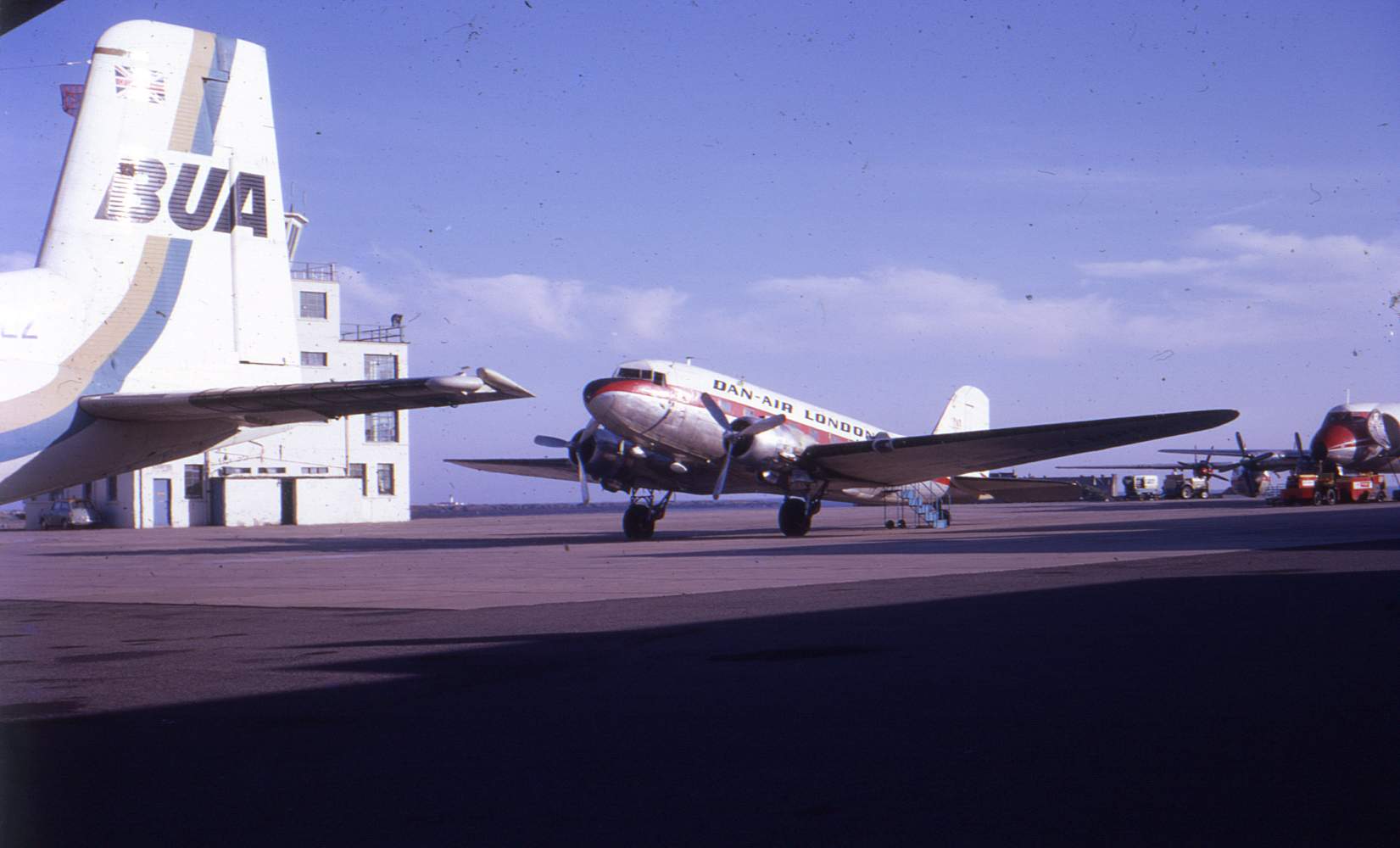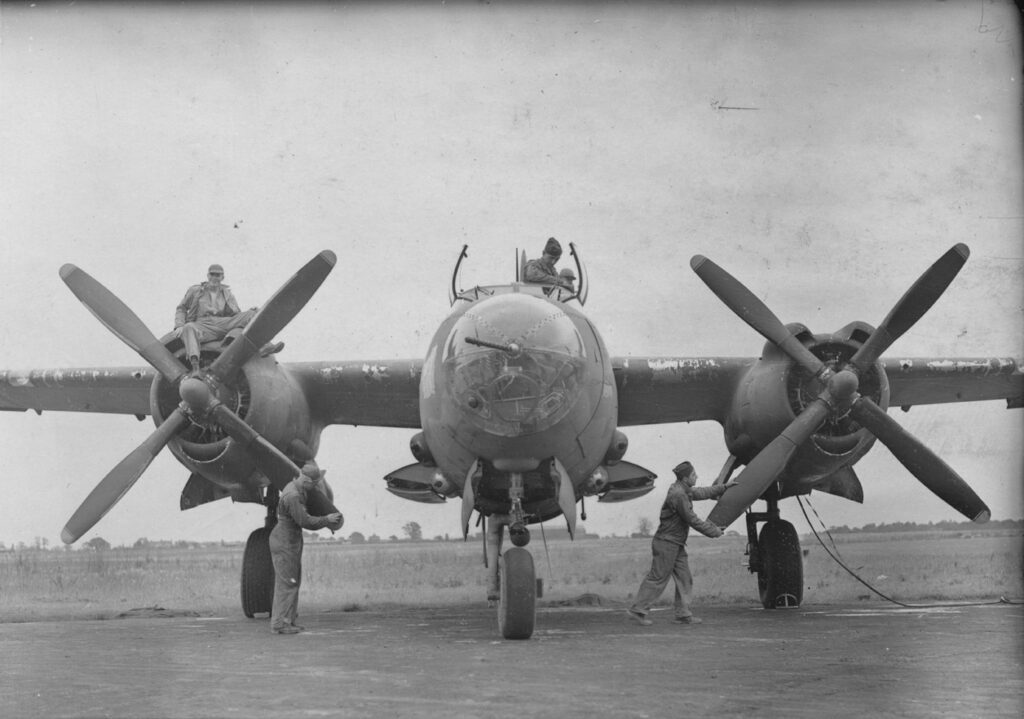
The B-17s of 94th Bomb Group moved to Bury St.Edmunds (also known as Rougham) on June 13th 1943. The Suffolk airfield had been home to 322nd Bomb Group but it had been decided that the B-26 Marauder medium bombers needed to operate from airfields slightly closer to targets in France. This reorganisation of the Eighth Air Force led to the 322nd moving southwards to take-up residence at Andrews Field, near the village of Great Saling, in Essex. The 322nd’s stay at Rougham had not been a fortunate one; the bombing accuracy on their first low level raids on the power station at IJmuiden in Holland on 14th and 17th May had been poor. On the second of these raids all ten B-26s which made it to the target were lost. This rate of attrition was increased by training crashes and the Eighth Air Force command decided to remove the Marauder squadrons from front-line operations, delay the deployment of further B-26 units to Britain and generally re-evaluate the practicality of low level bombing. However, three further B-26 Bomb Groups had been designated to join 322nd in the Third Bomb Wing. 323rd, 386th and 387th Bomb Groups had already arrived in Britain (10) and, prior to operations, were moved to the Essex airfields at Earls Colne, Boxted and Chipping Ongar respectively. The Headquarters of the Fourth Bomb Wing, which had been at Markshall, was moved to Elveden at the same time and the Third Bomb Wing replaced them at the historic hall at Earls Colne.
(10) The Mighty Eighth by Roger Freeman is the definitive text on the US 8th Air Force in Britain. First published 1970 by Macdonald & Janes.
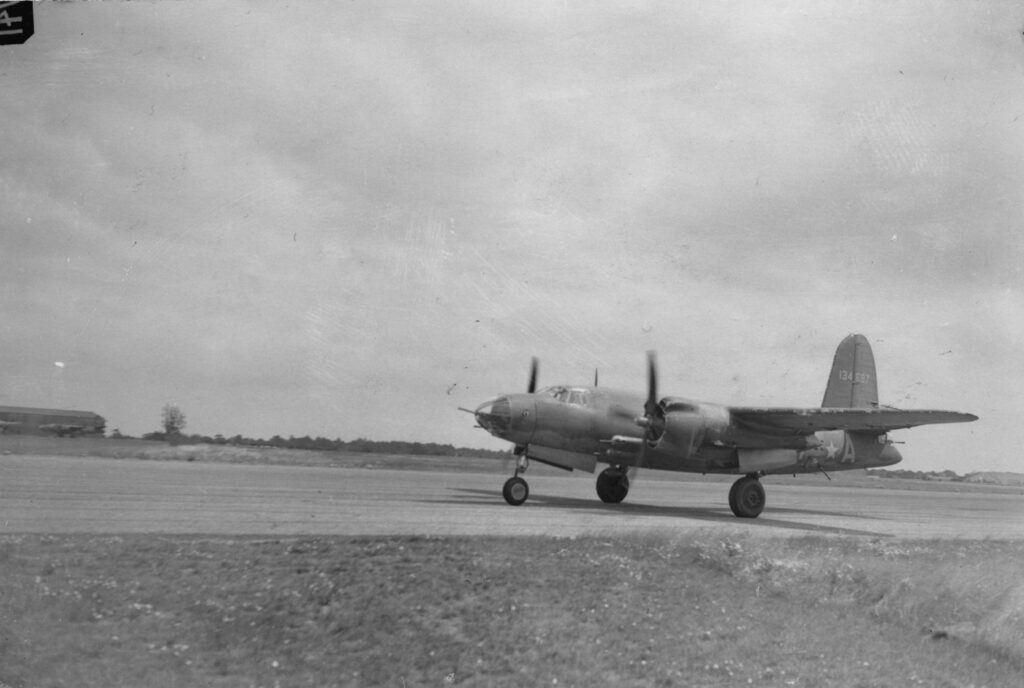
The 323rd Bomb Group was commanded by Colonel Herbert B.Thatcher and compromised 453rd, 454th, 455th and 456th Bomb Squadrons. The Group had been formed on June 19th 1942 and collected their Omaha-built Martin B-26C Marauders from Bear Field, Indiana, during early 1943. Three of the squadrons had taken the southern ferry route to Britain while 456th traveling slightly later in May 1943 had taken the ‘Blue Spruce’ route via Greenland and Prestwick.
After their initial arrival at Horham, 323rd’s move to Earls Colne meant that many more productive medium bomber targets lay within the Marauder’s 300 mile range. The B-26 had been designed to be fast, light, low-level bombers and retraining of crews began to adapt them for medium-altitude operations at between 10,000 and 15,000′. Early models of the B-26 had very short wings and small tails which, coupled with the powerful Pratt & Whitney R-2800 Double Wasps, gave high operational speeds but also high landing speed and doubtful control. The 322nd BG had initially been equipped with B-26Bs and the 323rd’s later deployment to Europe meant that they arrived with the improved B-26C. They were, however, still equipped for single-pilot operation which was not really suited to the suggested medium altitude missions. Similarly, the higher level regime demanded the fitment of the more sophisticated Norden bomb sights. These modifications took time and it was not until July 16th that the 323rd flew its first mission, Colonel Thatcher taking the lead in ‘Bingo Buster’.
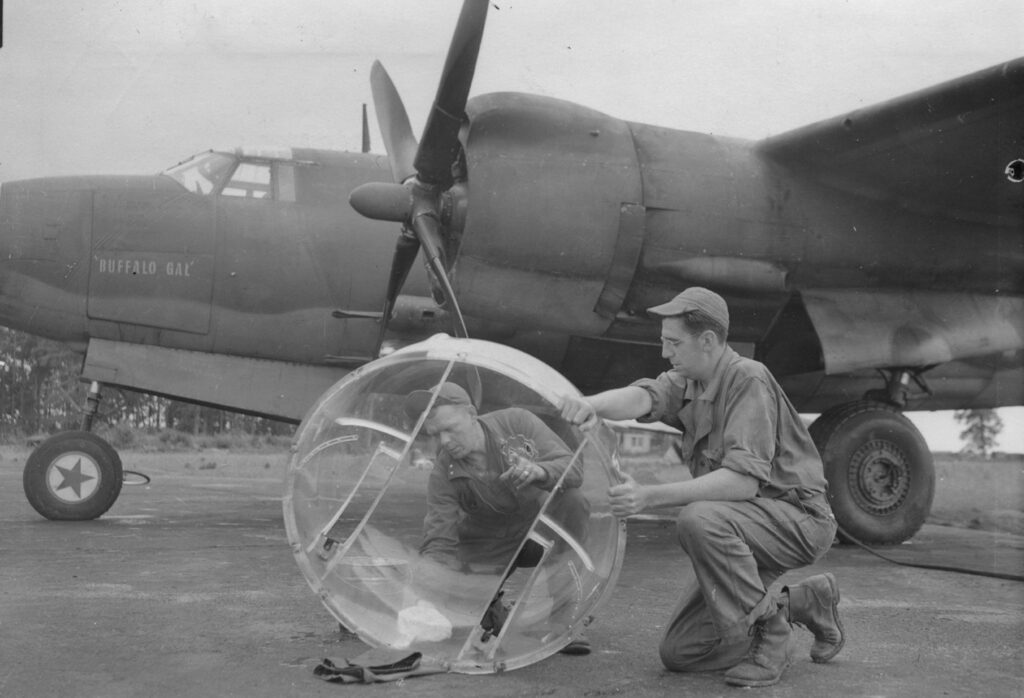
The B-26s flew in 3-aircraft ‘vic’ formations incorporated into 18-aircraft boxes which afforded maximised fields of fire towards attacking fighters. The medium bombers were much less heavily armed than their heavy bomber colleagues and extensive fighter cover was essential. The 323rd’s first raid from Earls Colne was also the Eighth Air Force’s first medium altitude mission and several squadrons of RAF Spitfires were dispatched to provide fighter support (11). The target was the Abbeville marshaling yards and 14 of the 18 B-26s dispatched managed to drop their bomb loads in the general target area. Flak damage was sustained by ten aircraft but enemy fighters were generally driven away by the Spitfires and all the Marauders returned safely to Earls Colne. The 323rd Bomb Group was back in action the following day to fly a diversionary mission near Cayeux. A week of inclement British summer weather impeded further operations until July 25th when 323rd launched eighteen B-26s on a raid to the Ghent coke ovens. Thirteen B-26s dropped 16 tons of bombs without noticeably damaging the target but all returned safely to base following the successful fending-off of Luftwaffe ME-109s by RAF Spitfires. Bombing accuracy improved and the next mission, on July 26th, saw 15 of the 18 B-26s dispatched dropping 15 tons of bombs on the airfield at St. Omer/ Longuenesse. Another airfield, Triqueville, was the primary target on July 27th and all but one of the 18 323rd BG B-26s dropped 18 tons of bombs on target. USAAF P-47 Thunderbolts were sent to provide fighter cover for the bombers as well as carrying-out a fighter sweep around Rouen. However, it was RAF Spitfires which, again, ensured the safety of the bombers, claiming the scalps of nine FW190s for the loss of one British aircraft. The RAF flier was rescued from the North Sea and all the USAAF B-26s made it back to Earls Colne without damage. July 27th had proved to be a very successful day and the following day was also due to be a big day for the Eighth Air Force. Over 300 B-17s were dispatched for targets in Germany and the Earls Colne Bomb group mobilised 36 B-26s. Eighteen were bound for the Zeebrugge coke ovens again while the other eighteen headed for the airfield at Triqueville. The latter group were recalled to base when they failed to rendezvous with their fighter escort while the eighteen heading for Zeebrugge successfully bombed the target and returned home without loss. The medium bombers had fared better than the heavies which had suffered fifteen B-17s missing in action. operations from Earls Colne were similarly fortunate for the rest of the month: the RAF provided a full twelve squadrons of Spitfires to escort the 323rd en route to and from the Fort Rouge airfield on July 29th but fog at the fighter stations on the 30th led to the recall of the 24 B-26s bound for the airfield at Courtrai. Twenty-one B-26s of 323rd were airborne on the morning of July 31st en route to bomb the airfield at Poix. 260 tons of bombs were dropped by 19 aircraft but, unfortunately, one Marauder was lost and five damaged during the mission. Two of the crew of the downed B-26, Staff Sergeants Hager and Crowe, evadd capture and returned to Britain via Spain and Morocco (11).
(11) Graham Smith’s ‘Essex Airfields in the Second World War’, Countryside Books, 1996, says that eighteen Spitfire squadrons accompanied the 323rd B-26s to Abbeville on July 16th as that area had some of the ‘best fighter units in the German Air Force’.
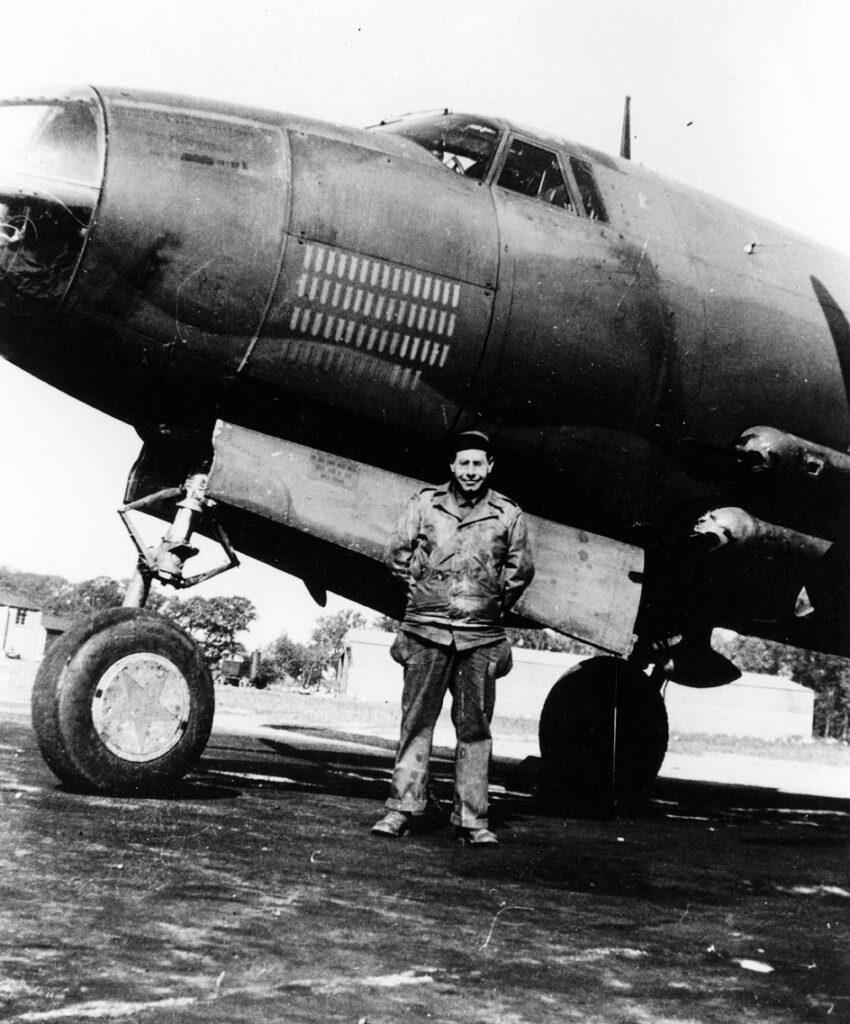
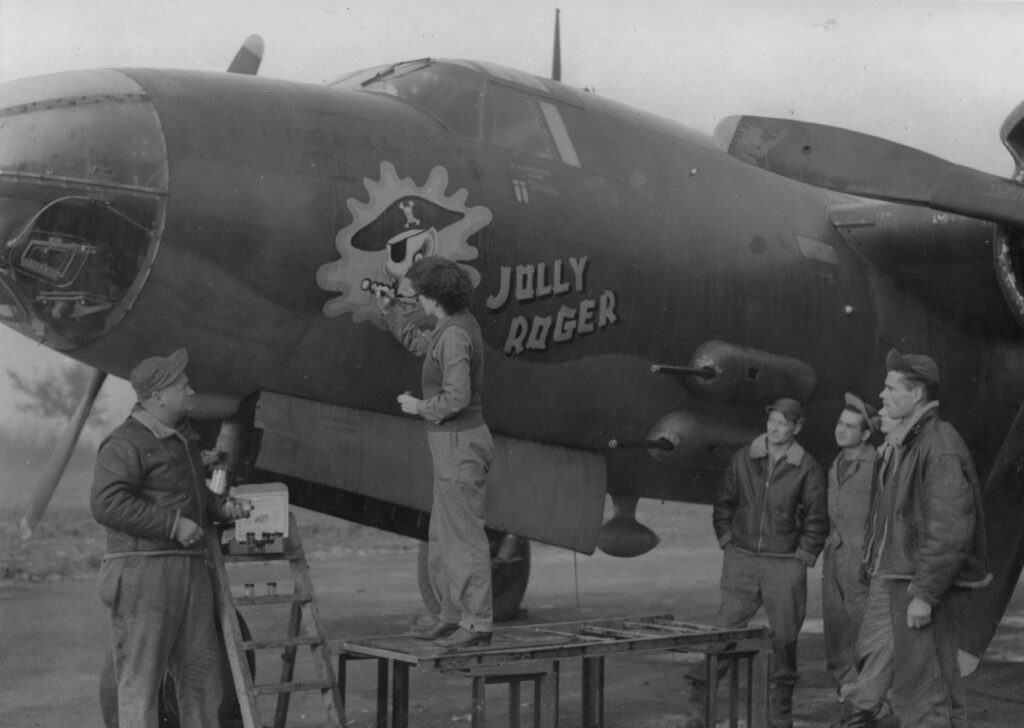
The 323rd’s operations from Earls Colne during August 1943 continued successfully and, gradually, the B-26 in its medium altitude role began to redeem its reputation. The slim and elegant Martin Marauders were referred to less often as the ‘Baltimore Whores’ and more as ‘Beautiful Ladies’. The medium bomber’s targets were generally airfields and marshaling yards. Thirty-four 323rd BG aircraft attacked the airfield at Merville on August 2nd and encountered the heaviest flak to date. Larger bomb loads were carried on shorter missions but the B-26s generally flew under maximum capacity in order to maintain speed and manoeuvrability. On Aug 2nd, 31 of the aircraft despatched successfully dropped 245 tonnes on Merville and returned with no losses. The medium bombers continued to rely upon extensive fighter support and, on August 12th, 323rd was recalled owing to fighter escort concerns. The 322nd BG went on to bomb Poix/ Nord with no losses. Three days later, the 323rd BG headed for the Abbeville marshaling yards on an evening raid with 21 aircraft. Nineteen of the complement bombed successfully although nine aircraft returned with damage. On August 17th the 323rd returned to the airfield at Poix again and 35 of the 36 B-26s bombed effectively. Twenty of the aircraft were damaged by the enemy but, again, all returned home to Earls Colne. This was the first day that the Third Bomb Wing had deployed over one hundred B-26s and, while twenty of the 323rd BG and two of the 386th BG aircraft suffered damage, all returned to their Essex bases. August 19th featured a morning raid on Poix, yet again, and all 36 aircraft were successful, delivering a total bomb load of 351 tons. The final raid of August for the Earls Colne Bomb Group involved an evening raid on the airfield at Caen Carpiquet. All 36 of the bombers were effective over the target and there were no losses although one B-26 did make a crash landing after overshooting during an emergency landing at Shoreham airfield.
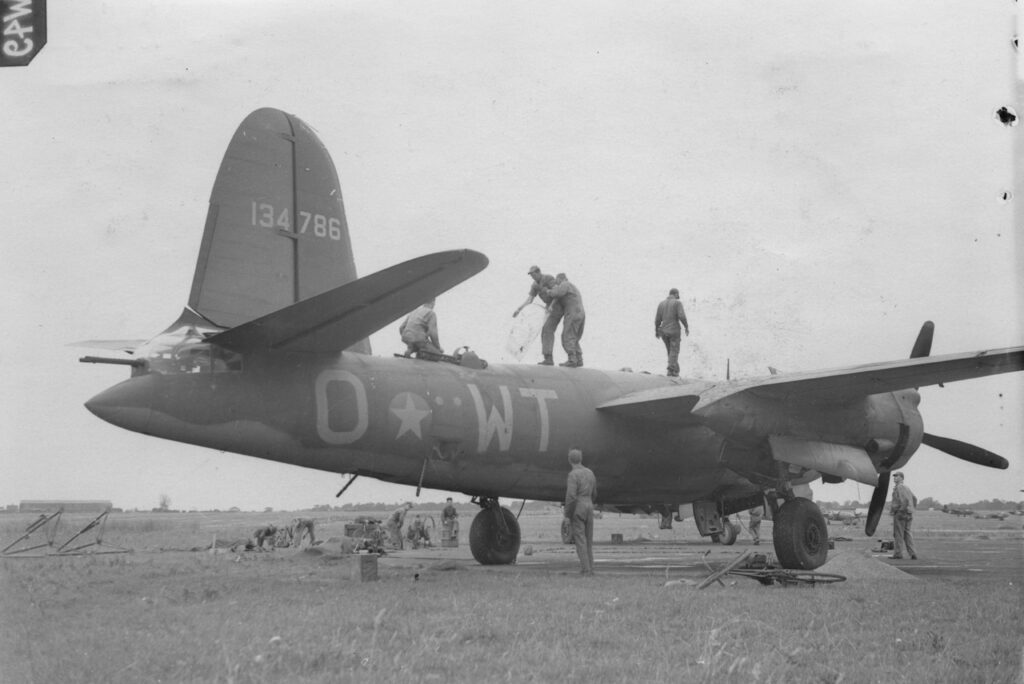
The Earls Colne Marauder operations continued in a similar vein during September 1943: aircraft were now being sent on medium height bombing missions in groups of 36 aircraft. The fuel dump at Hesdin was targeted on September 2nd, the airfield at Beaumont Le Roger on September 3rd, Hazebrouk marshaling yards on 4th, Ghent marshaling yards on 5th and again on 6th. returning to the same targets on successive days seemed to be forewarning the German defenders and, indeed, the Marauders did attract increasingly heavy flak, but it was deemed necessary as the Germans were proving adept at repairing bomb damage very swiftly. To partially mitigate the risk posed to personnel by anti-aircraft guns, crews were supplied with ‘flak suits’ and often flew wearing GI-style steel helmets (10). Course-changing was adopted where possible to throw-off the German gunners aim but, when making the final approach to the target, a straight run-in couldn’t be avoided. The marshaling yards at St.Pol were attacked by both 322nd and 323rd on the morning of September 7th, each Bomb Group furnishing 36 B-26s. The next day, the four 3rd Bomb Wing groups each supplied 35 or 36 B-26s for a morning visit to Lille. As a measure of the Wing’s growing commitment, a further mission was flown the same afternoon with each of the four Bomb Groups supplying eighteen B-26s for an attack on the coastal defences at Boulogne. The bombers were back at Boulogne the following morning, Sept 9th, but, this time, each Bomb Group each furnished 54 or 55 B-26s. Beaumont Le Roger was revisited by 35 bombers from Earls Colne on Sept 11th, Lille Nord airfield was the intended target on 15th and Triqueville on the evening of Sept 16th. The raids on Sep 17th and 18th saw 323rd aiming for Beaumont Le Roger again, followed by Merville airfield. The cloudy weather obscured the targets and, of 36 B-26s despatched each day, none were recorded as ‘effective’. Indeed, the Marauder’s strike cameras and subsequent photo reconnaissance continued to show the mixed bombing success achieved by individual bomb aiming and the 3rd Bomb Wing began using the ‘drop when the Lead Bombardier drops’ technique employed by the heavy bomber squadrons.
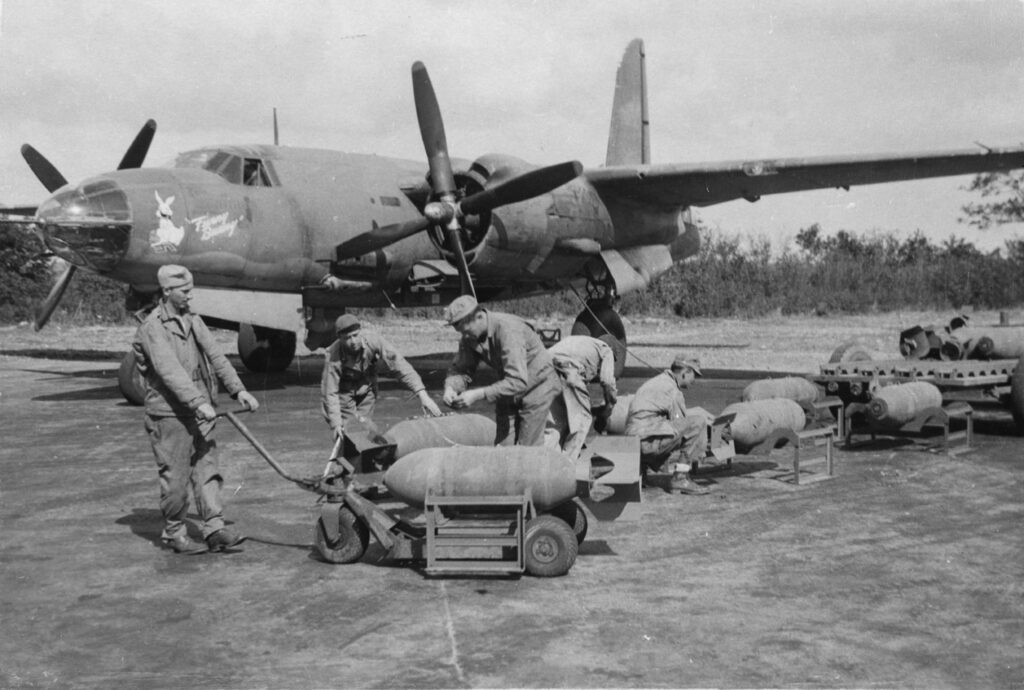
The afternoon of Sept 22nd saw thirty-six 323rd aircraft heading for the airfield at Evreux. Another airfield, Beauvais-Tille to the north of Paris, was targeted on the following two afternoons with 34 of the 36 aircraft dispatched bombing successfully on 23rd Sept. Weather intervened on 26th and the 36 Earls Colne-based B-26s were recalled from a raid on Conches. The raid was repeated successfully the next day with 33 of the 36 Marauders reaching the target. Beauvais was back on the agenda on October 3rd with eighteen 323rd B-26s participating. Evreux/ Fauville was scheduled for the following day but was a washout with none of the eight B-26s reporting as bombing successfully (12). Similarly, the mission on Oct 8th was scrubbed and the thirty six 323rd BG aircraft were recalled from a raid on Lille/ Vendeville owing to weather conditions. The next day was the last mission that the Eighth Air Force Third Bomb Wing B-26s flew before the four bomb wings were transferred to the Ninth Air Force. 323rd BG reported that 34 of the 36 B-26s sent to Woensdrecht airfield completed the mission effectively. The Third Bomb Wing Marauders had redeemed their reputation after the 322’s disastrous early raid of May 1943. The subsequent 90-odd medium altitude missions, comprising 4000 aircraft sorties, had resulted in the loss of only thirteen B-26s of which only one was due to fighter action. The 323rd BG had lost three aircraft due to enemy action while conducting Eighth Air Force operations.
(12) The Mighty Eighth War Diary, Roger Freeman, Janes Publishing, 1981.
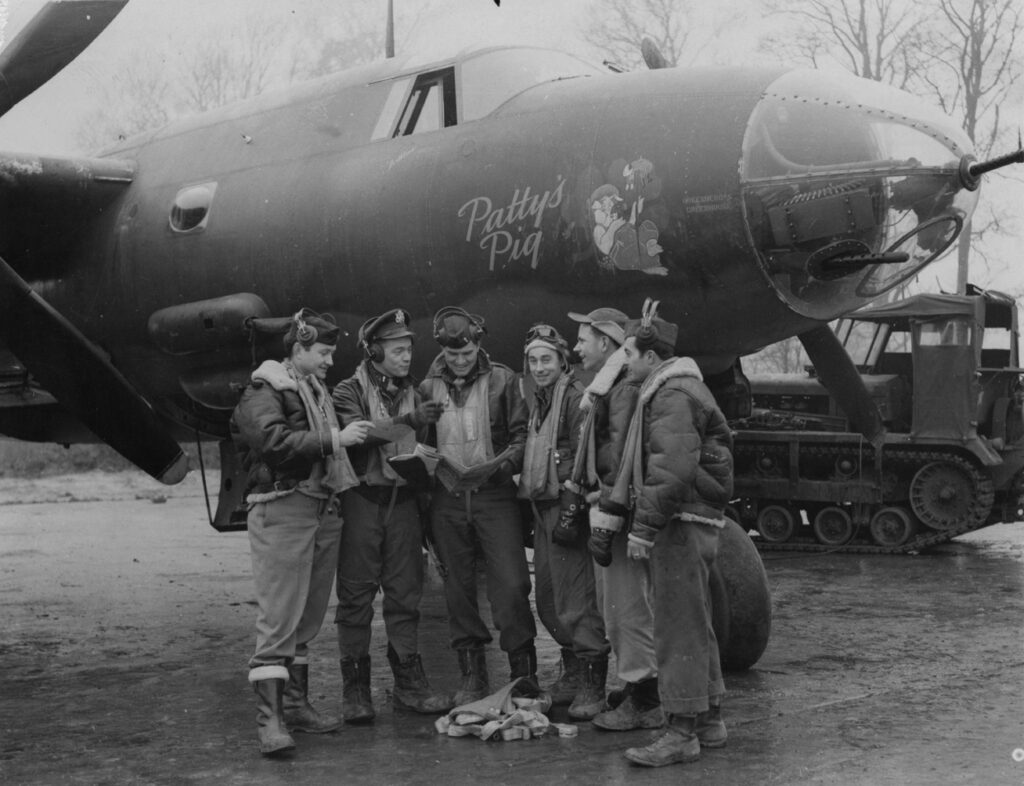
YANKEE QUEEN -An unscheduled visitor.
The story of B-17 ‘Yankee Queen’ illustrates some of the complications in sorting-out the details and recording even quite recent history.
The folklore: As a kid I remember catching newts and frogs at a cottage pond opposite the old concreted military road which led across the B1064 Coggeshall Road and down to the site of the bomb dump in Witches’ Wood. A field closer to Gatehouse Farm, on the west side of the B1064, there was what remained of a smallholding which, I was told, had been destroyed by a crashing US bomber during the war. From memory, there was a small, neglected orchard, a couple of redundant sheds (possibly old railway carriages?) and a bunch of derelict farm machinery. Our neighbour in Curds Road had been a bus conductor during the war and had a litany of stories about the airfield and the USAAF bombers. His version of events was that a B-17 Flying Fortress had crashed with a full bomb load and destroyed the farm. It seems that he was largely correct and that the farm wiped-out was White Gates. Other local sources mis-identified the unfortunate aircraft as one of 323rd BG’s B-26s and incorrectly placed the crash at Herons Farm or next to the ‘Bird in Hand’ pub.
The facts (*): The aircraft was B-17F 42-3283, ‘Yankee Queen’, of 95th Bomb Group’s 336th Bomb Squadron. She was based, not at Earls Colne, but at Horham in Suffolk and her last flight took place on October 4th 1943 when she had been part of 361 Eighth Air Force bombers despatched to hit industrial targets across Germany. On that day, 95th BG partnered with 385th BG, 390th BG, the ‘Bloody Hundredth’ 100th BG and ex-Earls Colne residents 94th BG in a 115-strong force bound for Saarlautern. Poor weather conditions precluded precision bombing and the B-17 force selected the secondary target instead: St Dizier airfield east of Paris. The 95th ran into quite sustained fighter opposition from FW190s over Europe but ‘Yankee Queen’ had encountered problems in advance of the Luftwaffe. Struggling from take-off onwards with engine problems, Pilot Harry O’Neal and Co-Pilot Frank Sances must have assessed the situation when approaching Earls Colne and decided to make an emergency landing. Approaching the airfield, the crew reportedly noticed that the main runway was obstructed and decided, instead, to attempt to land on runway 12/30. What is reported is that the bomber approached Earls Colne airfield with two engines on fire (+). S/Sgt David Goss, an armorer at Earls Colne recalled that ‘we knew he wasn’t going to make it and a bunch of us ran to where it looked as if he was going to try to set it down’ (^). Unfortunately, White Gates farm was in the bombers path: the pilot tried to ‘avoid the farmhouse by banking the plane over on its wing and (it) slammed in hard’. David Goss recollects seeing the pilot and co-pilot drop-out of the B-17: ‘the co-pilot was out cold and the pilot was dazed but he helped me get the co-pilot on my back and we got the hell out of there’. In Goss’ book, his friend John (likely to be fellow-armorer John W.Foutch) says that the B-17 was on fire, probably owing to the engine fire, and ‘we all knew it was fully loaded with fuel and a full bomb load’ (#). A WW2 Honoree plaque for Co-Pilot Frank Sances acknowledges that he was carried to safety ‘from flaming wreckage seconds before the gasoline tanks exploded sending a deluge of burning fuel in all directions’. The details of how the remaining crew escaped (if still on board) aren’t given; neither is there any information regarding the occupants of White Gate Farm itself, although the building was recorded as destroyed. Oddly, the Eighth Air Force records (*) seem to indicate that the aircraft was salvaged on 30th January 1944. This seems unlikely unless the entry indicates that some usable spares were recovered from the hulk.
The crew: Pilot: Harry O’Neal, Co-Pilot: Frank Sances Navigator: Draper Hand Bombardier: Joe Krapley Flight Engineer: Ernie Rape Wireless Operator: Warren Irving Ball Gunner: Chas Zakzeski Waist Gunner: Chas Stafford Tail Gunner: Stan Michaels.
(*) The information is largely from USAAF records as published in Roger Freeman’s three books ‘The Mighty Eighth’, the ‘Mighty Eighth War Diary’ and ‘The B-17 Flying Fortress Story’. David Osborne’s individual aircraft histories from the latter book were particularly informative and were compiled from USAF record cards. David Poulin’s monograph ‘The 453rd Bombardment Group’ quotes a work by S/Sgt David Goss , ‘Was this meant to be?’ which affords some extra detail.
(+) Some sources mention a fire in only engine #3.
(^) David Goss commentary from his book ‘Was this meant to be?’ via D.Poulin’s work ‘The 453rd BG’.
(#) website https://b-17flyingfortress.de mentions that the bomber had 1 x 1000 lb bomb on board which exploded but ‘others were made safe’. The 95th would have been carrying 1000GP bombs on the raid but would have had more than one. Nineteen of the twenty-one 95th BG aircraft are recorded as having hit the target.
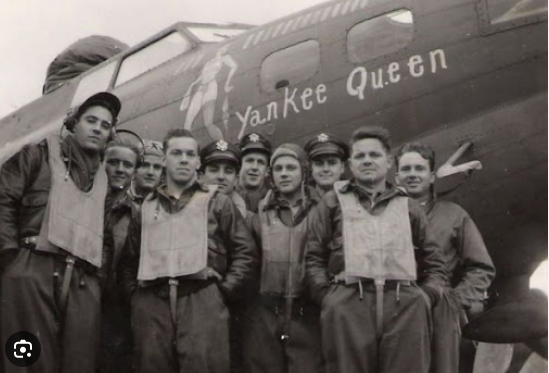
A NEW AIR FORCE AT EARLS COLNE
On October 16th 1943, Earls Colne welcomed a new air force while remaining home to the 323rd Bomb Group. The US Ninth Air Force had been formed in the Mediterranean theatre in 1942 and, amongst other types, had operated B-26s and B-25 Mitchells alongside RAF and South African Air Force Marauders. In anticipation of Operation Overlord, the Allied return to France, the Ninth was reborn in Britain with C-47 Troop Carrier Groups alongside the four B-26 Medium Bomb Groups transferred from the Eighth Air Force. Business was maintained in the Mediterranean by the US Twelfth Air Force which retained the B-25 squadrons. 322nd BG opened the Ninth Air Force’s British operations from Great Saling on 18th October and 323rd soon followed suit. Each Marauder group acquired distinctive markings and 323rd gained a white stripe across the fin which gave them the nick-name ‘White Tails’. Markshall, previously home to, successively, the 4th Bomb Wing and the 3rd Bomb Wing, now became the headquarters of the Ninth Bomber Command. Colonel Thatcher moved from 323rd BG to command the 99th Bomb Wing at Great Dunmow and ‘Chico’ Wood, previously commander of the 454th Bomb Squadron , moved up to command 323rd Bomb Group. The 323rd was placed in the 98th Bomb Wing under the command of 25-year-old Wilson Wood Roe.
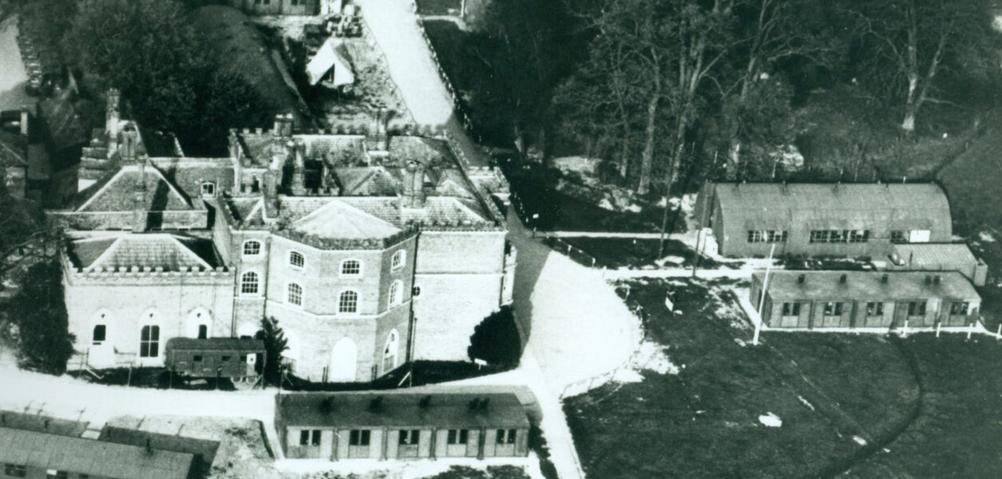
The Ninth started operations with only the four medium bomb groups but aimed to expand strike capability by increasing numbers of B-26s. November 1943 saw B-26 Bomb Groups organised into Combat Wings. In each case, two experienced bomb groups were to operate with two newly-arrived groups. the experienced 323rd at Earls Colne and 386th at Boxted were paired with newcomers 344th at Stansted and 391st at Matching. Other new arrivals were the 394th at Boreham and 397th at Rivenhall, next to Earls Colne, but none of the less-experienced groups started operations until February/ March 1944. This meant that, as preparations for D-Day stepped-up, the workload of the four original groups increased. Luftwaffe forward airfields, marshaling yards and gun batteries continued to be the main targets for the medium bombers along with a new speciality – V1 Flying Bomb sites (13). The concentration on V1 sites by 323rd BG started with a raid on Mimoyecques in france on Nov 5th 1943 and led to the Bomb Group acquiring the soubriquet ‘Wood’s Rocket Raiders’. Losses remained fairly low although one 323 B-26 was lost on december 13th during a raid on Schiphol, a notorious nest of flak activity. A further forty-six aircraft sustained damage. The RAF continued to provide fighter escorts although the USAAF contribution increased with the support of P-47 Thunderbolts and P-38 Lightnings. Winter weather was no longer such a limiting factor with the advent of Gee and Oboe radio systems to guide the formations. The four original bomb groups between them operated virtually daily operations, sometimes with both morning and afternoon missions. Airfields and railway targets remained a priority and, as from February 1944, the more recently-arrived groups joined the established four. 391st went operational from Matching on 15th February, 344th at Stansted on 6th March, 394th at Boreham on 23rd March and 397th at Rivenhall on 20th April.
(13) B-26 Marauder Units of the Eighth & Ninth Air Forces, Jerry Scutts, Osprey Publications, 1997.
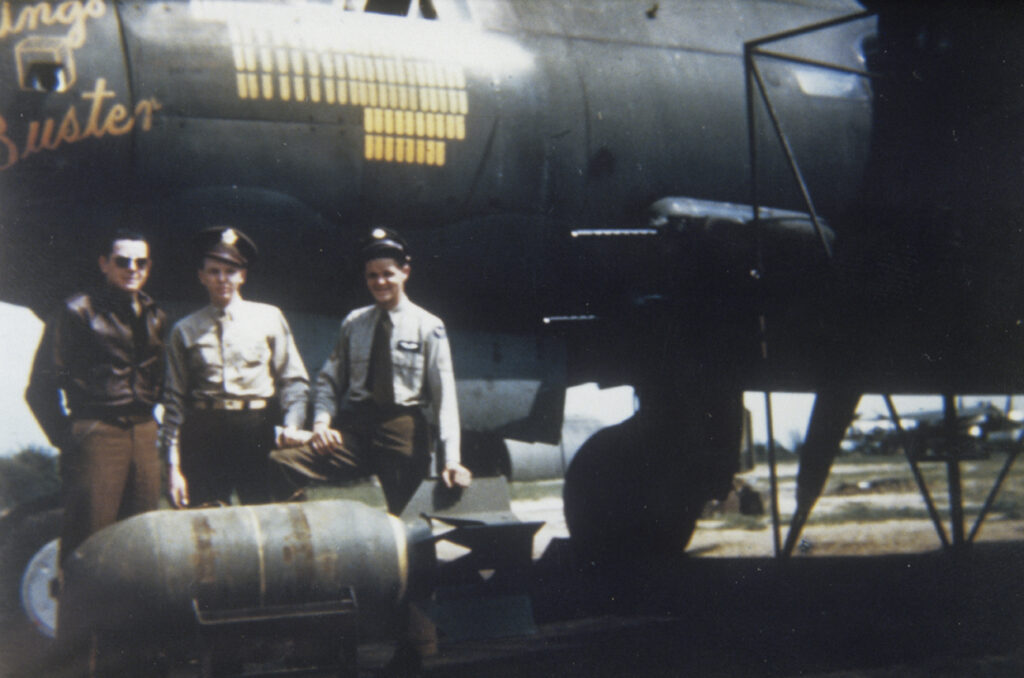
When 323rd BG reached their 100th mission with a raid on Bois Remprey on February 8th 1944, they were the first B-26 Group to achieve this. It would be May 1944 before individual B-26s of the original four groups began to reach the 100 mission threshold: 22nd’s Mild & Bitter was the first to hit a century on May 9th 1944 but 323rd at Earls Colne wasn’t far behind with 41-34863, Bingo Buster, achieving the total on May 16th. Often the mount of the CO Colonel Thatcher, ‘Bingo Buster’ returned to the USA in July 1944 for promotional purposes (14).
Other preparations for D-Day recognised that the Ninth Air Force units would need to move fluidly between European airstrips following the invasion. As a trial exercise, 323rd BG briefly moved to Great Dunmow on March 20th and 386th switched to Earls Colne. The 386th probably didn’t enjoy their stay at Earls Colne very much as their residence included a Luftwaffe bombing raid. In an incident which is widely remembered in local folklore, one of the invading Ju88s was shot down by an RAF night fighter and crashed on top of one of the B-26s at Earls Colne. Two of the German crew were killed in the accident but two had parachuted to (comparative) safety – they were rounded-up by the local Home Guard.
The 323rd had experience with rail marshaling yards, airfields and V1 sites but, from May 1944, they were scheduled to become ‘Bridge Busters’. Assessment of the efficiency of the B-26 groups during April suggested that the more-established groups were achieving poorer results than the hotshots recently arrived from the USA. Of course, the latter had just benefited from several months of training and ‘bedding-in’. Nonetheless, the 323rd were assigned to re-education and no operations were flown between 19th and 27th April (12). Subsequently, May proved to be a busy month with a double raid on Dieppe on 19th and 20th yielding heavy flak damage on both raids. Seventeen B-26s were hit on 19th, three lost and twenty damaged the following day. The sheet aluminium experts at Earls Colne must have been working overtime. Bridge operations for 323rd BG commenced on May 25th and nine bridges were attacked on successive days. Two further 323rd BG B-26s were lost on the first bridge mission, close to Liege.
(14) The third aircraft to crack the 100 mission ceiling was 322nd’s ‘Flak Bait’ which, despite living up to her name as a magnet for anti aircraft shrapnel, survived to complete 202 missions – the only US WW2 aircraft to achieve this. It has earned her a place in the Smithsonian Museum.
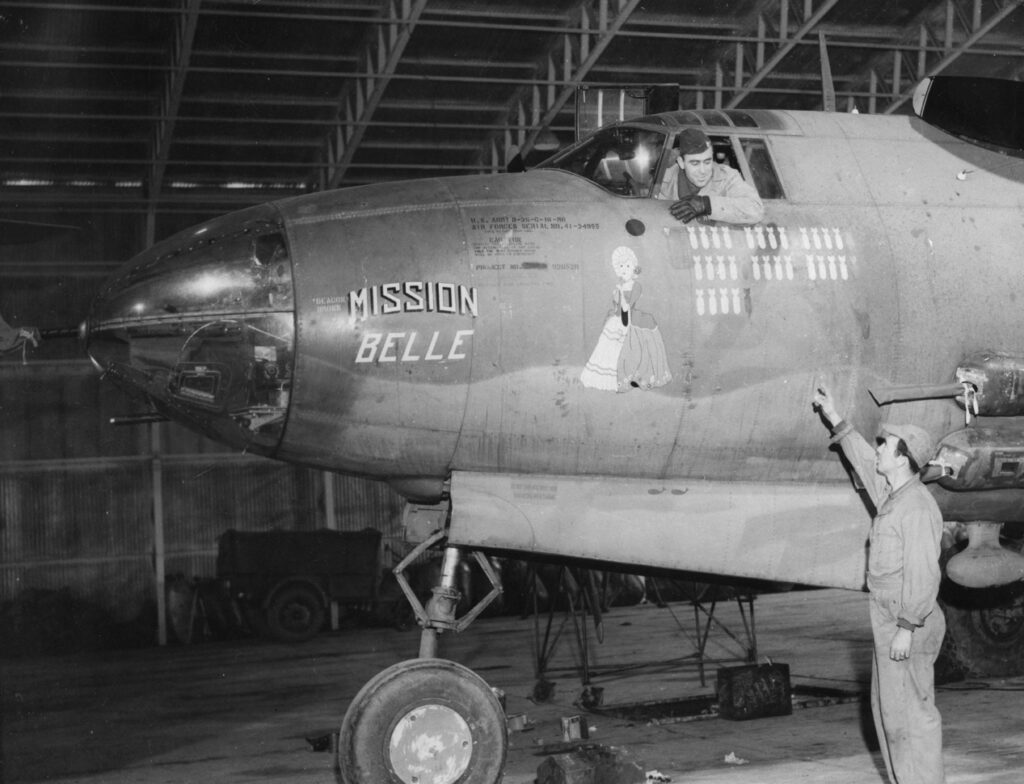
D-Day, June 6th placed further demands on 323rd BG. Instead of flying a single 36-aircraft mission, the Earls Colne outfit operated three 18-aircraft raids against coastal defences close to Utah beach. All 54 aircraft hit the targets shortly after 06:00 and returned home safely. A second 36-aircraft mission followed with a road junction near Caen as the target. Approaching at a flight level of 2-3000′, much lower than normal, the flak directed at the B-26s was intense and one aircraft from 455th Bomb Squadron was shot down. A further 21 missions were completed during June 1944 with many aircraft damaged and at least one further B-26 lost due to flak. Earls Colne was honored by a visit from two Generals on June 13th, General Marshall, US Army Chief of Staff and General ‘Hap’ Arnold, Chief of the US Army Air Force (15) (16).
July suffered from poor weather for aviating and there was less operational flying. Although the allies initial advance was slow, they were securely ashore in France and future targets for the Ninth Air Force would be further east into the Continent. Consequently, 323rd BG was scheduled to move to Beaulieu in Hampshire prior to eventual deployment to France. The final mission from Earls Colne was flown on July 18th with a 36-aircraft mission to soften-up German forces to the east of Caen. The target had already been pasted by a huge thousand-bomber RAF attack during the night. USAAF B-24s had also taken part in a raid that was designed to take-out a major German hub which was holding-up British and Canadian forces. The German flak was still intense by the time the 323rd’s B-26s arrived and damage was inflicted on twenty of the 323rd B-26s. Fortunately for the bombers, there was very little Luftwaffe interference by now as they were desperately short of fuel, fighters and pilots. The damage to Caen was huge, killing large numbers of French civilians and creating a sea of rubble through which it proved very difficult to advance. The troublesome German defences to the north of the City remained active.
The departure of the 323rd’s Marauder squadrons from Earls Colne ended an important chapter in the airfield’s history and also that of B-26 operations of the Ninth Air Force. The B-26 had gone from being a ‘jinx ship’ to a fast and efficient medium bomber which could soak-up haevy flak and still bring its crew home.
(15) Airfields of the Ninth, Then and Now, Roger Freeman, After the Battle, 1994.
(16) General ‘Hap’ Arnold had an amazing life story from his flight training with the Wright Brothers to hist post-war foundation of the RAND Corporation. Along the way he served alongside Billy Mitchell, was Chief of the Air Corps, a General in both the US Army and the US Army Air Force. General Marshall was the instigator of the post-war Marshall Plan for European regeneration.
The 323rd Bomb Group remained at Beaulieu for only just over a month before crossing the English Channel to the Advanced Landing Ground A20 at Lessay on the Cotentin Peninsula on August 26th. their next brief home was ALG A40 at Chartres which they occupied between 21st September and 13th October 1944. A69/ Laon-Athies followed until 9th February 1945 when 323rd moved to their last operational airstrip in Europe, A83/ Denain-Valenciennes. They flew their last mission from here on 25th April 1945, an attack on the airfield and Me262 site at Erding. The 323rd returned to the USA in December 1945, arriving home on 11th of the month.
Hits: 116
